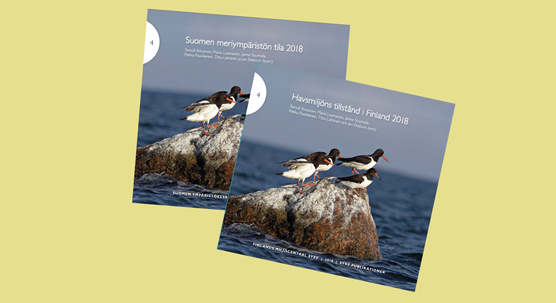
The new report about the status of Finland’s marine environment is published in Finnish and Swedish. It is available online free of charge. © Cover photo: Tomi Muukkonen
An extensive information package about the status of Finland’s marine environment has been published. The report, published by the Finnish Environment Institute, defines what a “good status” of the Baltic marine environment means. These definitions have been used to assess the state of the marine environment in 2011–2016. In many respects the state of the sea is not good, which is why the report also lists general objectives to improve it. The report contains research information from plankton to seals, nutrients and hazardous substances to litter, noise and impacts of human activity. At the same time the report also updates the information in the first part of Finland’s marine strategy from 2012, to be used for the update of the programme of measures concerning the marine areas.
The status of the sea is still poor but there are signs of improvement
“Our report shows that there are signs of improvement in the state of the Baltic Sea, even if as a whole the status is quite poor. Reductions in hazardous and harmful substances can be seen especially in the better breeding performance of top predators. The efforts to reduce nutrient loading are producing good results especially in the eastern parts of the Gulf of Finland”, says Samuli Korpinen, Research Director at the Finnish Environment Institute and one of the editors of the report.
Besides the status of the sea, the report also deals with loading caused by human activity and other human-induced environmental stress. In particular, the state of the sea is influenced by loading from the catchment: nutrients, hazardous and harmful substances and litter. Human activities have significant impacts on the sea, also reflected as a decline in seabird populations, endangerment of sea trout and habitat degradation.
This was the first time that the economic benefits of a good status of the sea were also assessed. These may rise up to EUR 430 million a year.
Different actions for different parts of the sea
Finland’s marine area as a whole suffers from eutrophication. We have managed to turn the total phosphorus loading from Finland to the Baltic Sea into a decrease from the peak levels in the mid-1970s. For total nitrogen loading the trend is not as clear, even if less loading is now coming from human communities.
However, there are differences between the marine areas. In the Gulf of Bothnia there is less eutrophication and the oxygen content near the bottom is still good. The populations of bottom fauna and various kinds of habitats are also in a better condition than in the Gulf of Finland, Archipelago Sea and northern part of the Baltic Sea. There are similar differences between the Gulf of Bothnia and other marine areas in the status of plankton colonies, seabirds and the Baltic ringed seal. In recent years eutrophication has also increased in the Bothnian Sea which so far has been in quite a good condition.
The aim is a good status of the marine environment
“In the marine strategy our aim is to achieve a good status of the marine environment. This status report serves as a knowledge base for the revision of the programme of measures of the marine strategy, which is to be launched next year. There is a particular need to target measures to the pressures and areas where a good status has not been achieved and where human-induced adverse impacts are the most obvious”, says Maria Laamanen, Senior Environmental Adviser at the Ministry of the Environment.
The report is closely linked to the assessment published by the Baltic Marine Environment Protection Commission HELCOM on the state of the Baltic marine environment as a whole and the pressures affecting it, published in summer 2018. With respect to Finland the themes used for the HELCOM assessment are the same as in this report.
More than 80 Finnish experts from the Ministry of the Environment and the Centre for Economic Development, Transport and the Environment of Southwest Finland, as well as the Finnish Environment Institute, participated in preparing the report. The Finnish Environment Institute published the report in the publication series that requires scientific peer review in order that the reliability of the results was verified by external reviewers. The content of the report was reviewed by two Swedish researchers specialised in the Baltic Sea.
The new report about the status of Finland’s marine environment is available online free of charge.
The report in Finnish: Suomen meriympäristön tila 2018
The report in Swedish: Havsmiljöns tillstånd i Finland 2018